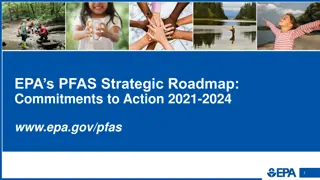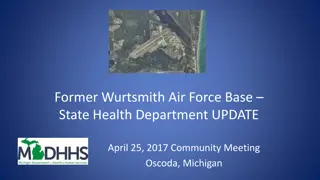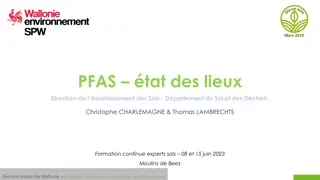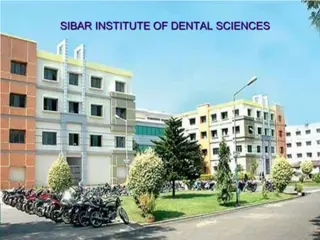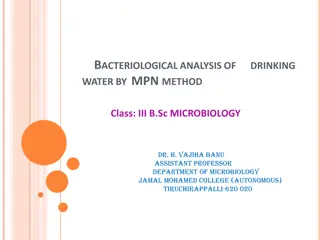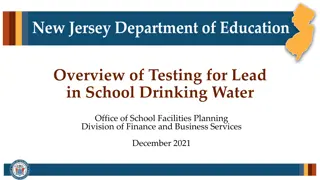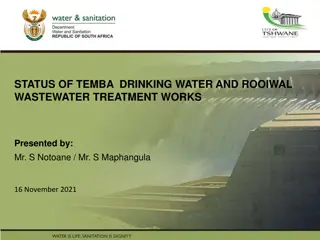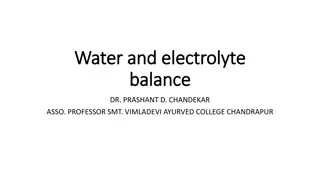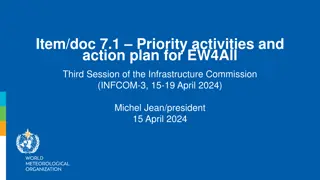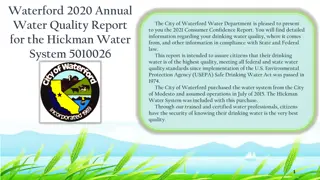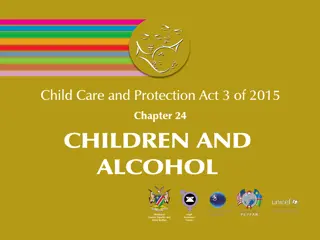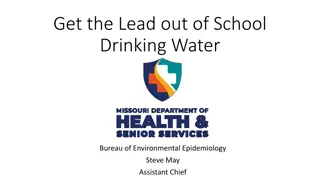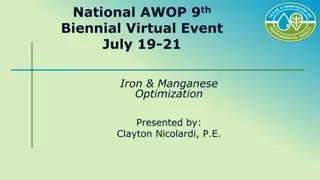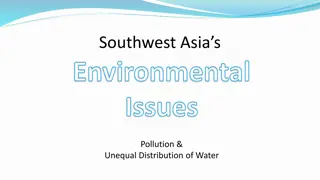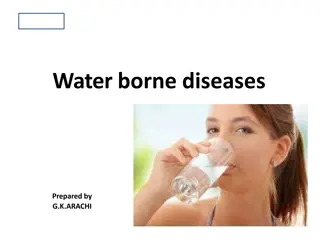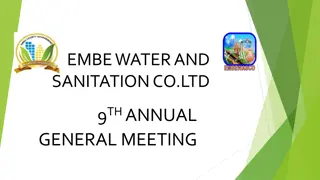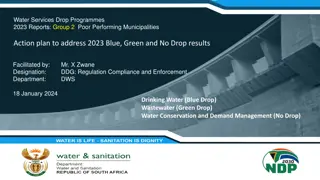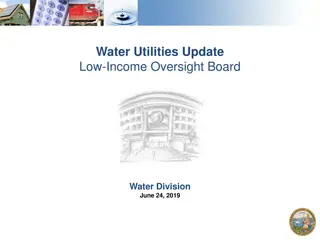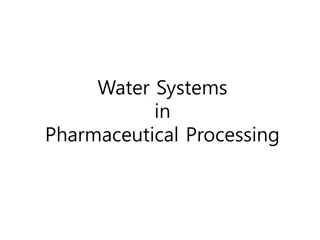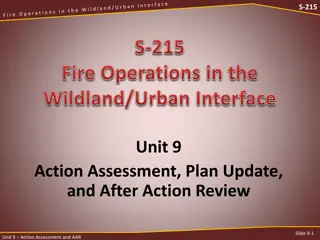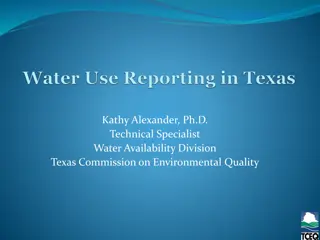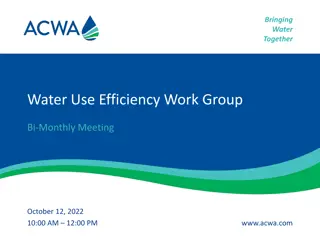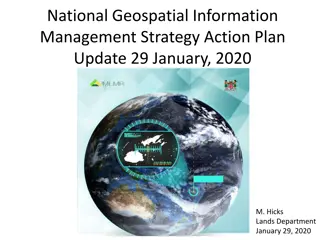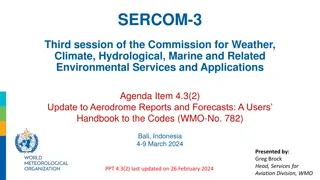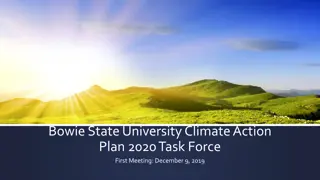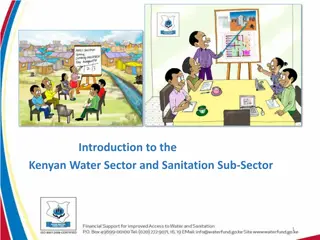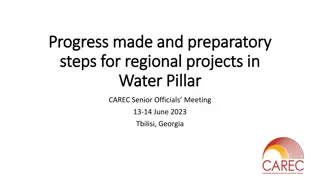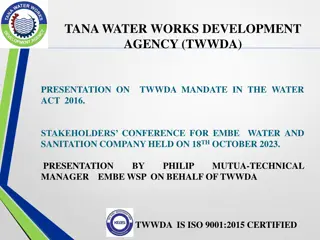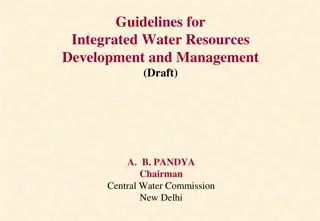EPA's PFAS Action Plan and Drinking Water Activities Update
EPA's PFAS Action Plan, unveiled in February 2019, outlines a comprehensive approach to addressing PFAS challenges nationally. The Agency is committed to regulating PFOA and PFOS and proposes nationwide monitoring for PFAS in drinking water. Additionally, the Technical Support Center (TSC) is actively involved in method development, validation, and oversight, particularly focusing on PFAS compounds in drinking water and radiochemical analysis updates.
Download Presentation

Please find below an Image/Link to download the presentation.
The content on the website is provided AS IS for your information and personal use only. It may not be sold, licensed, or shared on other websites without obtaining consent from the author. Download presentation by click this link. If you encounter any issues during the download, it is possible that the publisher has removed the file from their server.
E N D
Presentation Transcript
SDWA Program Update ACIL Environmental Sciences Section March 27, 2019 Daniel Hautman (hautman.dan@epa.gov) Deputy Director Technical Support Center (TSC) OW, OGWDW, SRMD 1
EPAs PFAS Action Plan (Feb. 2019 ) Provides EPA s first multi-media, multi-program, national research, management and risk communication plan to address a challenge like PFAS. Responds to the extensive public input the agency has received over the past year during the PFAS National Leadership Summit, multiple community engagements, and through the public docket. Drinking Water Commitments The EPA is committed to following the MCL rulemaking process as established by SDWA. As a next step, EPA will propose a regulatory determination for PFOA and PFOS by the end of this year. The Agency is also gathering and evaluating information to determine if regulation is appropriate for other chemicals in the PFAS family. The EPA will propose nationwide drinking water monitoring for PFAS under the next UCMR monitoring cycle. 2
Drinking Water Activities within TSC Method development/validation/review/approval (including coordination of the DW Alternate Testing Procedure program and Expedited Method Approval), Coordination of the national DW Lab Cert Program with direct engagement and oversight of regional and state lab cert programs, UCMR development (planning for UCMR 5) and direct federal implementation program (currently UCMR 4), and DW treatment plant technical assistance through the DW Area Wide Optimization Program working directly with regions, states and PWSs. 3
Drinking Water Method Development LC/MS/MS method for select short chain PFAS compounds including GenX, ADONA, perfluorinated polyethers and select AFFF compounds o Expected to be published this summer. o Includes 25 PFAS GC/MS method for low molecular weight water soluble CCL compounds, ethyl carbamate, urethane and N-methyl-2-pyrrolidone. Potential method revisions o EPA 548 (endothal) CRITICAL NOTE: TSC is looking to collaborate with laboratories to further improve these methods and to participate on method validation 4
EPA Radiochemical Method Updates TSC continuing to update EPA radiochemistry methods and assess new capabilities for radiochemical analysis. Working with Standard Methods and ASTM radiochemistry committees Updated EPA Method 900.0 (evaporative gross alpha and gross beta) Feb 2018 o More in-depth calibration details and quality control to improve consistency in generating analytical data. o Corrects discrepancies between the requirements in the older approved Method 900 and criteria specified in the regulations (e.g., alpha calibrant). o Formally approved in October 12, 2018, Expedited Methods Approval FRN Work continues with revisions planned to 903.0, 903.1 and 904.0 5
Expedited Method Approval Continue to annually release Expedited Method Approval FRNs October 2018 approved 100 additional DW methods including: o The revised EPA Method 900 o Chemistry, radiochemistry and microbiology methods in 23rd Ed. of Standard Methods o Two Hach methods for turbidity reviewed through ATP Anticipate next Expedited Methods Approval FRN later this year 6
UCMR Activities UCMR 4 (2017-2021) Monitoring Period 2018-2020 Laboratory Approval Program no longer active NCOD first set of monitoring data released in late 2018. UCMR 5 (2022-2026) Pre-proposal stakeholder meeting July 2019 Proposal expected summer 2020 start of Lab Approval Program Final Rule late 2021 Monitoring Period - Jan 2023 - Dec 2025 7
Assistance / Collaboration New EPA Method validation multilab validation, LCMRL formulation. Benefits: o Early experience with methods that may be used in future UCMR cycle o Acknowledged within the cover of the EPA method as a contributing validation laboratory rich fodder for marketing. o CONTACT: Steve Wendelken (wendelken.steve@epa.gov), TSC Chemistry Laboratory Manager and copy me UCMR 5 early engagement/assistance with MRL derivation - EPA often needs laboratory assistance generating LCMRL data sets to formulate proposed rule MRLs. Particularly for methods developed years ago with older instrument technology. Benefits: o Gain early skills preparing for future UCMR lab approval program o Acknowledgment in front cover of future UCMR cycle lab approval manual o CONTACT: Brenda Bowden (nee Parris bowden.Brenda@epa.gov), UCMR Rule Manager and copy me 8
Who knows about AWIA? America s Water Infrastructure Act of 2018 ( AWIA ), Section 2021 - MONITORING FOR UNREGULATED CONTAMINANTS Creates new UCMR requirements, subject to the availability of appropriations and contingent on sufficient laboratory capacity. Requires that all drinking water systems serving between 3,300 and 10,000 persons monitor for unregulated contaminants (in addition to those serving >10,000). Original SDWA provisions called for monitoring at all systems serving >10,000 and only a representative set of systems serving < 10,000. Authorizes (but does not appropriate) funds for each fiscal year in which monitoring is required to be carried out. Funds used for small-system sample analysis costs. AWIA provisions apply to UCMR 5 and cycles thereafter. 9
Future Opportunities AWIA BOTTOM LINE relative to UCMR future: More than 7 times the number of small PWSs than in prior UCMR cycles, will need to be monitored with EPA utilizing contract labs. ~5800 small PWS vs 800 small PWS EPA establishes multiple award laboratory contracts for this support with a guaranteed minimum. Labs need to be approved in all methods to cover complete analyte list. EPA will need at least 6, possibly 10 contract labs for UCMR5. Interested? Register your lab immediately after we propose UCMR5 (anticipated summer to late 2020), Submit complete applications as soon as you can, Get into the first PT study offered by EPA, Earn status early as an EPA approved UCMR5 lab. NOTE: AWIA authorizes (but does not appropriate) funds 10


